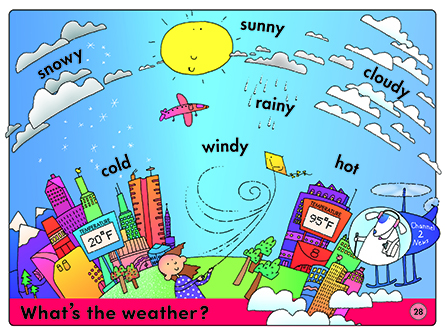Additional Activities
These activities offer options for continuing the learning in this unit. Whether your curriculum is skill-based or more open-ended, select the activities that are most appropriate for the children in your classroom. The Writing Spot is primarily a writing program, but writing can be integrated throughout your curriculum—in art, drama, reading, math, and science.
-
Do a weather-related experiment.
First explain what a thermometer is and how it works. Then place the thermometer in a jar of warm water and check the temperature. Next, place the thermometer in a jar of cold water and check the temperature. Implement "Hot and Cold Days." These sheets could provide words and phrases for a class weather poem.
-
Create finger-painted weather scenes.
As a response to stories and poems about the weather, have the children use finger paints to depict different kinds of weather. Ask them to add interesting words to describe their weather paintings—breezy, bright, noisy, blustery, drippy, sticky, and so on.
-
Respond to weather sounds.
Use watercolors, crayons, or other media to let children respond to a recording of weather sounds. Tell them that they may add weather words or feeling words to their artwork. They may wish to write (or copy) a short poem or sentence to capture the feelings that the weather sounds evoke.
-
Draw weather scenes and write weather words.
Invite children to draw themselves in a weather scene—on dark construction paper. Then, to add sparkle to the art, provide a mixture of equal measures of flour, water, and salt in a squeeze bottle, and have the students add snow, sleet, rain, or sand to their pictures. Add sparkling weather words, too.
Watch the weather forecast and choose a day for this activity when a significant change in the weather is predicted. Have children chart the weather throughout the day. Is it sunny? Cloudy? Clear? Rainy? Put a thermometer outside the window and chart temperature changes each hour. Talk about the ways in which weather changes. Use the Internet to find a live radar picture of the weather in your area. Near the end of the day, check the Internet for the next day’s forecast.
Contact local television stations in your area and ask one of their meteorologists to visit your school or classroom. Have the children prepare questions to ask their guest. After the visit, have each child write down at least one new thing he or she learned about weather. Invite children to make and send thank-you cards to the visiting weather expert.
If possible, find a sound recording of thunder, wind, rain, hail. Have children tell you the words that describe each sound. (They may also make up sound words.) Then insert the students’ words into this poem, and have everyone read it in unison.
Thunder says, __________ .
Wind answers, _________ .
Rain cries, __________,
and Hail replies, ____________ .
-
Study thunder and lightning.
Explain that lightning is a jolt of electricity that travels inside a cloud, between clouds, or from a cloud to the earth. The rapid heating and cooling of the air nearby the lightning causes a shock wave that makes thunder. You see lightning before you hear the thunder because light travels faster than sound. Challenge the children to learn other facts about thunder and lightning. Talk about stories children may have heard to explain thunder. Have the children create a class book about various types of storms (tornadoes, hurricanes, cyclones, dust storms, cloudbursts, hailstorms, windstorms). Place it in the writing center.
Some children may be afraid of storms. You can alleviate their fears by explaining the safety rules to follow during storms. Do a shared writing, making a list of storm-safety rules to post in the classroom. FEMA (Federal Emergency Management Agency) has an excellent Web site for kids. The students can also listen to live NOAA Weather Radio.
-
Describe how weather can affect people’s feelings.
Share these lines from a song: It’s raining. It’s pouring. The old man is snoring. Ask children why the old man might have gone to bed when it started to rain. Talk about different kinds of weather. Have children describe how they feel when they are hot or cold, wet or dry. How do they feel on sunny days, rainy days, snowy or stormy days? Make lists of feeling words under key weather words. Put the word lists in the writing center for children to use as they create new stories and poems.
